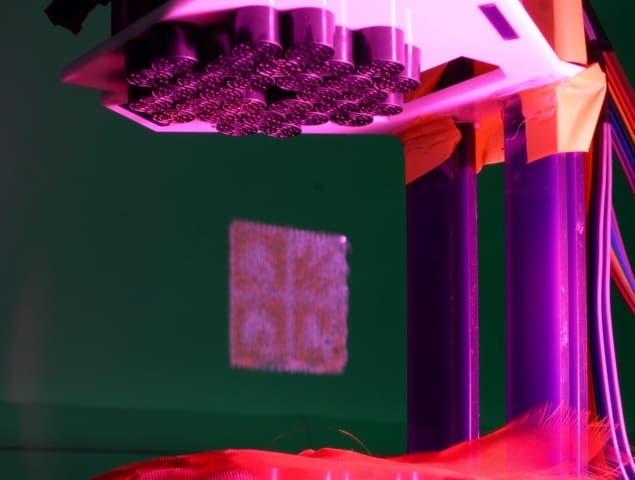
A midair visual display that uses a single acoustically-levitated particle has been unveiled by researchers in Spain and the UK. Dubbed an “acoustophoretic display”, the image is created by using two ultrasound transducer arrays to levitate the particle and manipulate it to trace out the desired graphic at high speed.
In 2015, Asier Marzo at the Public University of Navarra and Bruce Drinkwater at the University of Bristol created a sonic tractor beam that used ultrasound to levitate, rotate and move objects. Using a single grid of 64 off-the-shelf loudspeakers controlled by a programmable array of transducers the device created 3D fields of sound – acoustic holograms – that could hold and manipulate a small polystyrene particle in mid-air.
Since then, the field has progressed and earlier this year Marzo and Drinkwater revealed an acoustic levitation device that used two grids of speakers to hold and individually manipulate up to 25 polystyrene balls at the same time. This opened up the possibility of new applications for sonic tractor beams, including visual displays created with multiple levitated particles.
According to Marzo, such acoustic generated images, which he calls acoustophoretic displays, would offer an advantage over current holograms as they would not suffer from clipping. “[With holograms] the image can only be viewed from determinate angles and the frame of the display occludes the image, it is like looking inside a window,” he explains. “With the acoustophoretic displays the images reside in the physical space and can be observed without clipping from 360°.”
Many-body problems
But when the team tried to create displays using many levitated particles they had some problems. “We were trying to levitate multiple particles and make them form the shape at any given time,” Marzo told Physics World. “However, this leads to coarse graphics given the limited number of particles and the minimum distance between them, which is governed by the wavelength – approximately 1 cm.”
Undeterred, Marzo, Drinkwater and colleagues came up with another idea: using a single illuminated particle travelling at high speeds to trace the path of the image. While using multiple levitated particles like pixels would be similar to the way liquid-crystal, plasma and organic LED displays work, Marzo points out that using a single particle to trace the image is reminiscent of the way cathode-ray tubes use electron beams to create displays.
The idea is that if you levitate a single illuminated particle and move it very fast and precisely you can create the illusion of an image. This relies on persistence of vision – the capacity of the eye to briefly maintain an image on the retina after it has disappeared, enabling successive images (that follow quickly enough) to be perceived as one image.
University logo
At the recent 177th Meeting of the Acoustical Society of America the team revealed its new system , which comprises two grids of 30 ultrasonic speakers and an illuminated, 0.7 mm polystyrene particle to create a 12×12 mm image of the University of Bristol logo (see figure).
Creating the display involved the development of a novel calibration method that allowed them to improve the accuracy with which they could position the particle. They claim that they reduced the positional error of the levitation device down to 0.11 mm and 0.03 mm in the horizontal and vertical axes, respectively. These developments allowed the particle to move at a speed of 60 cm/s, while maintaining an accurate enough trajectory to create the image.

Sonic tractor beam grabs hold of large objects
“We needed to increase the communication speed so that we can rapidly reconfigure the sound field emitted by the device,” explains team member Tatsuki Fushimi. “The biggest challenge has been understanding the particle dynamics and the operation of our electronics at these high speeds. For the next iteration we are going to need even faster hardware and also more powerful acoustic emitters.”
Bristol’s Tom Hill told Physics World that while the current graphics are quite simple he believes the technique is promising. He adds that the team are developing algorithms to compensate for the inertia of the particle to create more accurate traces. They are also working to increase the speed of the particle. This would allow longer traces and therefore larger images. Soon the researchers hope to move to speeds of 400 cm per second, Hill explains, which would allow them to draw a 10 cm square or a 3 cm cube – graphics that require the particle to travel 40 cm ten times a second.
Looking to the furure, Marzo says the team would like to have multiple particles tracing the graphics as “that would allow for more complex figures to be created, but at the moment we are focused on the dynamics of a single particle”.
- In related research, Marzo has joined forces with scientists at Bristol and the University of Glasgow to create an acoustic levitator that is controlled by hand gestures. The system levitates multiple polystyrene spheres that are 3 mm in diameter. A user gestures towards the sphere to be manipulated, which can then be directed by the user’s hand. The device provides haptic feedback to the user and the system could find use in the manipulation of fragile objects such as biological samples.



